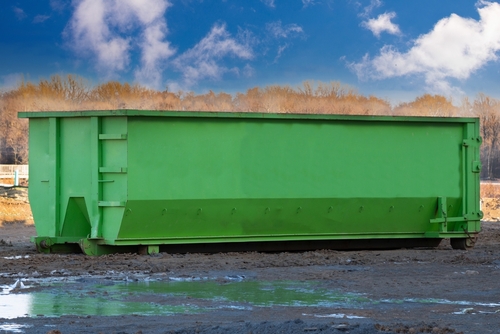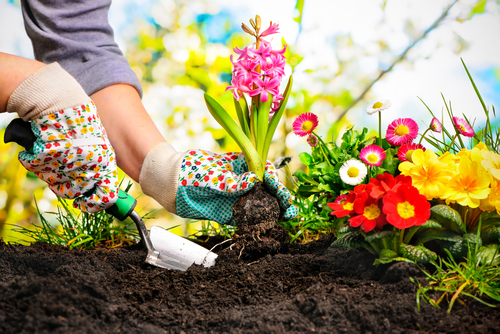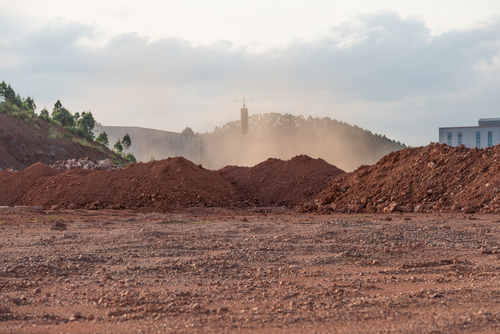May 14, 2024 - Benjamin Ehinger
How to Dispose of Dirt from Your Yard: Efficient Removal Strategies
CALL NOW 844-762-8449
When embarking on a landscaping project or simply managing the natural accumulation of yard waste, you’ll likely find yourself needing to dispose of excess dirt. It’s important to handle this task properly to maintain the health of your landscape and adhere to environmental guidelines. A common and convenient method is using a small yard waste dumpster rental from Waste Removal USA for dirt disposal. This strategy not only streamlines the process but also ensures that the dirt is disposed of in a responsible manner.
Understanding the composition and potential contaminants in your soil can determine the most suitable disposal or repurposing method. If the dirt from your yard is free from pollutants, there might be eco-friendly disposal options available, such as recycling the soil for other landscaping projects. For larger volumes or contaminated soil, professional junk removal services are often a necessary option, where specialists can manage the safe removal and disposal of the dirt.
 When dealing with excess dirt from your yard, it’s important to focus on methods that will benefit the environment. You have options such as transforming organic material into compost or taking advantage of local dirt recycling programs. Both approaches ensure your yard waste doesn’t go to waste.
When dealing with excess dirt from your yard, it’s important to focus on methods that will benefit the environment. You have options such as transforming organic material into compost or taking advantage of local dirt recycling programs. Both approaches ensure your yard waste doesn’t go to waste.
For guidance on how to transform garden trimmings into compost, explore Honestly Modern’s tips on yard waste.
 Sometimes the dirt you have from a landscaping or construction project can be reused in ways that benefit the environment and community. Instead of disposing it, consider these constructive alternatives for your excess soil.
Sometimes the dirt you have from a landscaping or construction project can be reused in ways that benefit the environment and community. Instead of disposing it, consider these constructive alternatives for your excess soil.
Key Takeaways
- Renting a small dumpster can efficiently manage dirt disposal.
- Identify soil conditions to choose an appropriate disposal method.
- Consider recycling or professional removal services for excess soil.
Understanding Soil and Dirt
When dealing with yard dirt, you need to understand the aspects of soil composition and the potential presence of contaminants. These factors affect the method you’ll use for disposal.Soil Composition and Types
Soil is a complex mix of minerals, organic matter, gases, liquids, and organisms that together support life. Your yard dirt, a type of soil, typically consists of sand, silt, and clay in varying proportions. These components not only influence soil texture and fertility but also determine the best disposal methods. For instance, a soil with high clay content can be more challenging to dispose of due to its density and potential for compaction. Here’s a brief overview of common soil types:- Sandy Soil: Quick draining, doesn’t hold nutrients well.
- Silty Soil: Rich in nutrients, more fertile than sandy soil.
- Clay Soil: Poor drainage, very fertile, compact easily.
Identifying Contaminated Soil
Contaminated soil can pose environmental and health risks, so it’s crucial to identify any potential contaminants before disposal. Soil testing comes into play here; it’s the process of analyzing soil samples to determine contaminant levels. You may test for a range of substances, including heavy metals, pesticides, or petroleum products. To check for contamination, consider the soil’s history:- Was it in contact with chemicals or hazardous materials?
- Is it from an area near industrial sites or heavy traffic?
Dirt Disposal Options
When you’re looking to clear your yard of excess soil, two efficient solutions are renting dumpsters specifically designed for soil or having the dirt hauled away by a professional service.Renting Dumpsters for Soil
Renting a local dumpster is a straightforward method for disposing of large amounts of dirt. You can choose from various dumpster sizes depending on the volume of fill dirt you need to dispose of. Pricing may vary depending on your location and the rental period, but it tends to be a cost-effective choice, particularly for sizable projects. Dumpster Size Guide:- 10-yard dumpster: Suits small to medium projects
- 20-yard dumpster: Ideal for medium to large undertakings
Having Dirt Hauled Away for You
If you prefer a hands-off approach or don’t have the means to transport soil to a landfill, consider having your dirt hauled away for you. This service is usually charged by the cubic yard, and though it can be more expensive than rental, it relieves you of all manual labor. Ensure you understand the cost implications as prices fluctuate based on dirt amount, location, and accessibility. Services Offered:- Flat-rate pricing: Predictable cost without surprises
- Cubic yard pricing: Payment based on the dirt volume
Eco-Friendly Disposal and Recycling
 When dealing with excess dirt from your yard, it’s important to focus on methods that will benefit the environment. You have options such as transforming organic material into compost or taking advantage of local dirt recycling programs. Both approaches ensure your yard waste doesn’t go to waste.
When dealing with excess dirt from your yard, it’s important to focus on methods that will benefit the environment. You have options such as transforming organic material into compost or taking advantage of local dirt recycling programs. Both approaches ensure your yard waste doesn’t go to waste.
Composting Yard Waste
Composting is an eco-friendly way to handle organic material from your yard. You can convert leaves, grass clippings, and even certain types of clean fill dirt into nutrient-rich compost. To start:- Create a compost pile by alternating layers of green waste (like grass clippings) with brown waste (like dry leaves).
- Maintain the pile, making sure to turn it periodically to help the decomposition process.
- Once matured, use your compost to improve soil health in your garden.
| Step | Action |
|---|---|
| Start Your Pile | Mix green and brown materials. |
| Maintenance | Turn your pile regularly. |
| Utilization | Apply compost to your garden soil. |
Utilizing Local Recycling Programs
Your second option is to leverage local recycling programs dedicated to dirt recycling. These facilities take clean fill dirt and repurpose it for construction and landscape projects. Here’s what you should do:- Contact your local facility to learn about guidelines and whether they accept yard dirt.
- Prepare your dirt for recycling by removing any non-soil materials such as roots, rocks, or debris.
Professional Junk Removal Services
When you have a large amount of dirt to dispose of, professional junk removal services can be your go-to solution. These services can handle the heavy lifting and removal of dirt from your property, offering a cost-effective and efficient option.Hiring a Removal Company
To facilitate the dirt disposal process, consider hiring a junk removal company to take care of the heavy lifting for you. These companies have the necessary equipment and expertise to remove large quantities of dirt quickly and safely from your yard. When you choose a removal company, make sure they are reputable and have experience dealing with waste removal and particularly dirt, which can be heavier and more cumbersome than other types of yard waste.Cost Considerations of Removal Services
The cost of dirt removal can vary widely based on a few key factors: the amount of dirt you need removed, your location, and the pricing structure of the junk removal service. Most companies charge by volume, or by the truckload, while some may offer pricing based on the type of materials being hauled away. It’s important to ask for estimates from several junk removal companies to find the most cost-effective service for your needs. Keep in mind that while budget is an important consideration, the reliability and efficiency of the service should also weigh into your decision.Alternative Uses for Excess Dirt
 Sometimes the dirt you have from a landscaping or construction project can be reused in ways that benefit the environment and community. Instead of disposing it, consider these constructive alternatives for your excess soil.
Sometimes the dirt you have from a landscaping or construction project can be reused in ways that benefit the environment and community. Instead of disposing it, consider these constructive alternatives for your excess soil.
Donating to Community Projects
You can make a positive impact in your community by donating excess dirt to local community projects. Parks often need soil for landscaping and maintenance. Contact a local park or community garden to see if they need additional topsoil. Similarly, consider offering your soil to a construction site, especially ones focused on public property development. By doing so, you’re promoting community growth and sustainability.Improving Your Own Landscaping
Reusing soil can significantly enhance your home’s landscaping. Use the excess dirt as topsoil to enrich your lawn or as a foundation for new grass growth. In your garden, extra dirt can support gardening efforts, helping to cultivate robust beds for vegetables or flowers. If the project is too big to tackle alone, don’t hesitate to reach out to a landscaping company. They can guide you on how to use your soil effectively on your private property, ensuring optimal use and beautification of your space.Frequently Asked Questions
When tackling the task of disposing of dirt after yard work, you may have numerous questions. Below, you’ll find answers to some of the most common inquiries, providing you with the knowledge to handle soil disposal effectively.What are some effective methods for dirt disposal after yard work?
Effective methods for disposing of dirt include renting a yard waste dumpster, taking the soil to a local landfill, or repurposing it for landscaping projects. Companies specializing in junk removal can also be hired to handle the dirt for you.Can I find places that will accept excess soil for free?
Yes, you may find landscaping companies, construction projects, or community gardens willing to accept excess soil at no cost. It’s essential to ensure the soil is clean and not contaminated before offering it.What are the cheapest soil disposal options available?
The least expensive options might be to dump dirt yourself at a local landfill or find a community fill site where you can dispose of it free of charge. Another option is to advertise it as free fill to those who can pick it up.How can I locate dirt and rock dump sites in my area?
To locate nearby dirt and rock dump sites, check with your local waste management or search online for local landfills and their accepted materials. Some may have specific requirements for the type of debris they accept.What should I do with soil that I have excavated from my property?
Options for excavated soil include using it to level other parts of your yard, creating raised plant beds, or contacting a soil removal service if you cannot repurpose it.Are there any city or municipal programs for soil waste removal?
Certain cities and municipalities offer programs for soil waste removal, often as part of their waste management services. These might involve drop-off days for yard waste or special pickups for large amounts of soil. It’s best to contact your local government or waste management department for information on available services.RECENT BLOGS
Our Reviews
Glenda Lanier Prowell
1721758635
I have ordered an 11 yard dumpster to be delivered to my house.Lonier was extremely helpful and answered all my questions. The rate was very reasonable.
Cedric Smikle
1721660395
Amber was extremely professional and courteous. She answered all of my questions and even some that I didn’t know I needed to ask.
Cait Kaider
1721243051
I highly recommend Waste Removal USA for their responsiveness and how the staff work hard to provide exceptional customer service. They have done well by us and our clients. Thank you!
Easom Family
1721223306
Louiner Pierre-Louis Is awesome! Did a great job. Will definitely be using this same company for all my dumpster needs because of his awesome customer service! Thank you!!!
tabitha Vazquez
1720539988
Wonderful and fast customer service!
LATEST BLOGS






